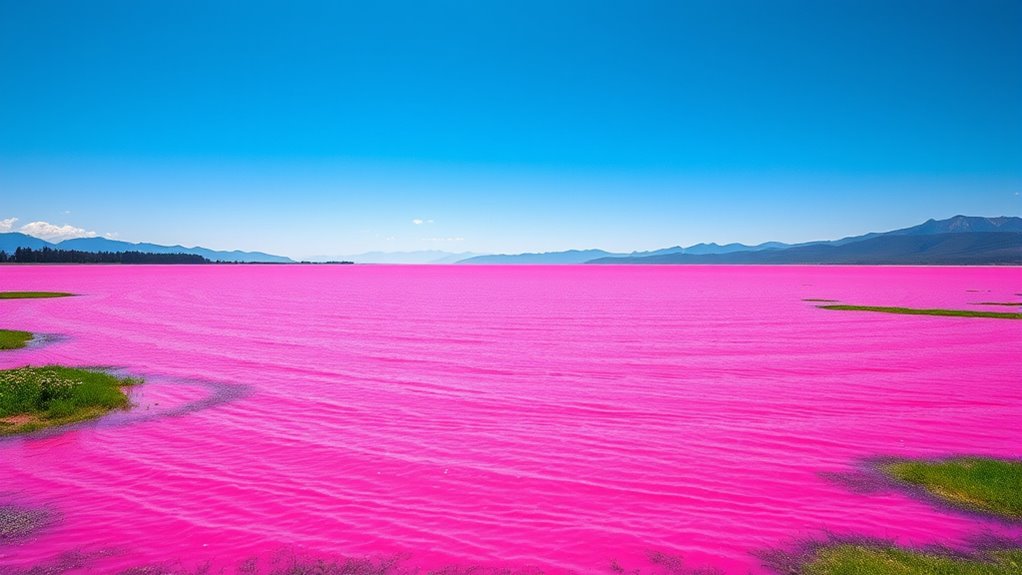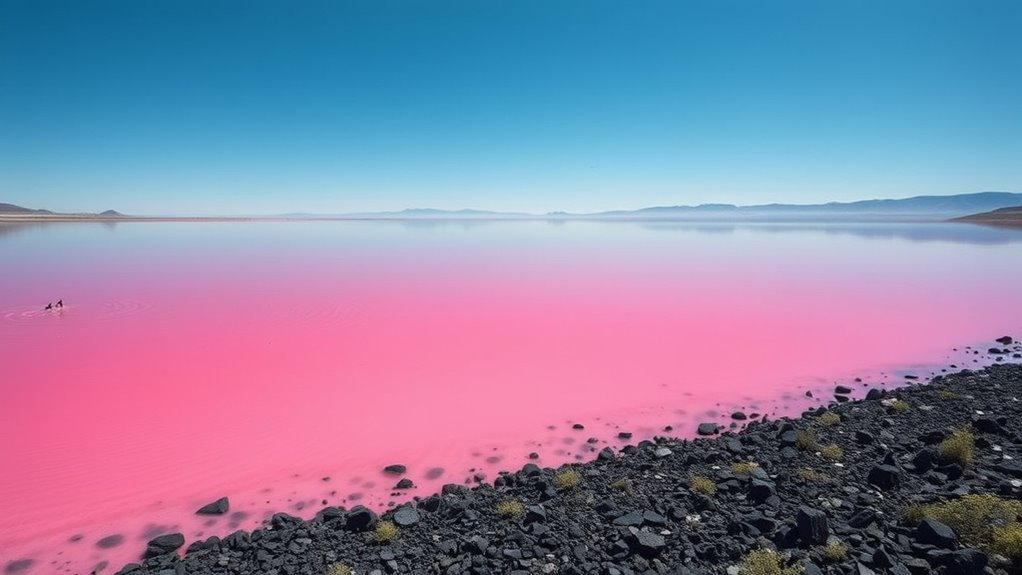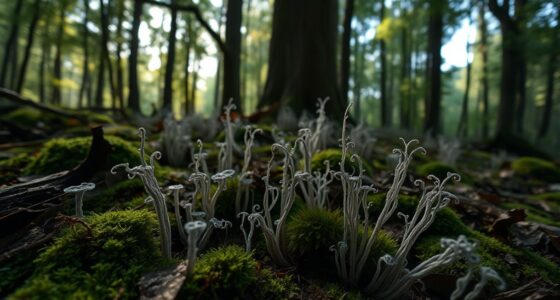Lakes turn pink mainly due to algae blooms, like Dunaliella salina, that produce vibrant carotenoid pigments such as beta-carotene, which give water a pink hue. Mineral deposits and high salinity also contribute to the color change. These phenomena often indicate specific environmental conditions that can affect wildlife, sometimes causing oxygen depletion or stressing aquatic life. If you want to discover how these colorful lakes impact ecosystems and what they reveal about nature, keep exploring.
Key Takeaways
- Pink lakes often result from algae blooms, especially Dunaliella salina, producing carotenoid pigments like beta-carotene.
- Mineral deposits, such as iron or magnesium, can alter water color and indicate high mineral concentrations.
- These color changes signal environmental conditions like high salinity, temperature, or nutrient levels affecting ecosystem balance.
- Algae blooms may deplete oxygen levels upon decay, potentially threatening aquatic wildlife.
- Such phenomena serve as natural indicators of ecological shifts and can impact local biodiversity and habitat health.

Have you noticed lakes around the world turning striking shades of pink? It’s a mesmerizing sight that often sparks curiosity and concern. The vibrant hues are usually caused by natural phenomena involving algae blooms and mineral deposits. These factors combine in unique ways in different lakes, creating stunning pink waters that seem almost surreal. But what does this mean for the environment and the wildlife that depends on these lakes? Let’s explore the reasons behind these color changes and their implications.
Algae blooms are one of the primary culprits behind the pink coloration. Certain types of algae, especially Dunaliella salina, thrive in salty or alkaline environments and produce carotenoid pigments like beta-carotene. These pigments act as a sunscreen for the algae, protecting them from intense sunlight, and give the water its characteristic pink or reddish hue. When conditions are just right—warm temperatures, high salinity, and abundant nutrients—these algae can multiply rapidly, creating a vivid bloom that transforms the lake’s appearance. The result is a spectacular display, but it’s also a sign of particular environmental conditions that may not be ideal for all forms of aquatic life.
Mineral deposits also play a significant role in the lakes turning pink. In some lakes, mineral-rich waters contain high concentrations of elements like magnesium, calcium, or iron, which can influence water color. When evaporation causes the water level to drop, these minerals become more concentrated and can precipitate out, sometimes forming deposits along the shores or floating on the surface. The interplay between mineral deposits and algae blooms can intensify the pink coloration. For instance, iron-rich waters may develop reddish hues, while other mineral compositions may lend different shades. These deposits are often harmless to wildlife, but they highlight the complex chemistry of these lakes.
For the local ecosystems, the pink coloration can have mixed effects. In some cases, the rapid algae growth can deplete oxygen levels when the algae die and decompose, threatening fish and other aquatic species. Conversely, certain microorganisms and invertebrates have adapted to thrive in these extreme conditions and may even benefit from the abundance of algae. Overall, these phenomena serve as natural indicators of changing environmental factors—such as salinity, temperature, and nutrient levels—that influence the health and diversity of lake ecosystems.
Understanding why some lakes turn pink is vital for evaluating ecological health and predicting future changes. These color shifts are not just beautiful spectacles; they are signals from nature about the delicate balance within aquatic environments. While they often pose challenges for wildlife, they also remind us of the complex, dynamic processes shaping our planet’s lakes.
Frequently Asked Questions
Can Pink Lakes Be Safely Visited by Tourists?
You can safely visit pink lakes, but it’s important to follow visitor guidelines. Tourist safety depends on respecting signs and staying on designated paths, as some areas may have sensitive ecosystems or unstable ground. Always check local regulations before visiting, and avoid swimming or disturbing the environment. With proper precautions, you can enjoy the stunning scenery while protecting yourself and the unique wildlife that thrives there.
How Long Do Pink Lakes Typically Retain Their Color?
You might wonder how long a pink lake keeps its striking color. The truth is, lake longevity varies depending on factors like salinity, algae, and environmental conditions. Typically, the color persistence can last from a few days to several months. Heavy rain or changes in water chemistry can fade the hue quickly, so the vibrant pink may not last long. Keep an eye out for the best time to visit and enjoy its unique beauty.
Are There Any Health Risks Associated With Pink Lakes?
You might wonder if pink lakes pose health risks. While they’re usually safe for visitors, some lakes have toxic algae or mineral imbalances that can cause health issues like skin irritation or respiratory problems. It’s best to avoid swimming or ingesting water from lakes with unusual colors, especially if you notice foul odors or algae blooms. Always check local warnings to stay safe while enjoying these stunning, natural sights.
Do Pink Lakes Indicate Environmental Pollution?
You might wonder if pink lakes signal environmental pollution. While they can sometimes be pollution indicators, many pink lakes result from natural factors like algae or bacteria thriving in high salinity. The environmental impact varies; in some cases, it shows pollution, but often it’s a natural phenomenon. So, pink lakes don’t always mean pollution, but they can serve as important indicators of environmental change or health.
Can the Color Change Affect Local Ecosystems Long-Term?
Did you know that lakes turning pink often signal algal blooms or mineral deposits? This color change can impact ecosystems long-term by disrupting food chains, harming aquatic life, and altering water quality. If these phenomena persist, they can lead to reduced biodiversity and ecosystem imbalance. So, yes, the color change could have lasting effects, especially if it results from environmental stressors or pollution that encourage harmful algal blooms.
Conclusion
As you watch a lake turn pink, it’s like witnessing nature’s own secret paintbrush at work—a reminder that even in change, there’s beauty and resilience. This vibrant hue symbolizes life’s delicate balance, warning us to protect these shimmering mirrors of the Earth. When the waters glow, it’s a call to cherish and preserve, understanding that each splash of color reflects the health of our world. Embrace the pink, and let it inspire your care for nature’s masterpiece.









